Tom's Hardware Verdict
The Asus ROG Strix 750W is dead silent and achieves high performance, but it is expensive.
Pros
- +
Full power at 47 degrees Celsius
- +
High performance
- +
Efficient
- +
Silent operation
- +
Good build quality
- +
Long cables
- +
2x EPS & 4x PCIe connectors
- +
Fully modular
Cons
- -
Expensive
- -
Transient response at 3.3V
- -
<70% efficiency with 2% load
- -
Not compatible with the alternative sleep mode
- -
Not so efficient 5VSB rail
- -
Small distance between connectors
Why you can trust Tom's Hardware
The Asus ROG Strix with 750W max power achieves high performance, and on top of that, it features dead silent operation (Cybenetics LAMBDA-A). Nevertheless, its price is stiff, with the competing offerings from Corsair (RM750x), Seasonic (Focus GX-750), and XPG (Core Reactor 750W), costing notably less. The main difference between the Rog Strix units and the similar capacity Seasonic models are the larger heat sinks, which allow for lower fan speeds, dropping the noise output significantly. But are you willing to pay a price difference of around 35 dollars for this?
The ROG Strix power supply line consists of only two models, with 650W and 750W max power. Seasonic makes both and, to be more specific, they utilize the Focus Plus Gold platform, which the Seasonic GX-650 and GX-750 models also use. This is a highly popular platform, offering a high performance per buck ratio. Asus asked Seasonic for some hardware changes to make its models as quiet as possible. The significant difference is depicted on the beefier heat sinks, which allow for a lower airflow, consequently less noise output from the fan. The second, major, difference is the double ball-bearing fan, which is more suitable for operating under high operating temperatures, compared to fluid dynamic bearing fans,

Product Photos

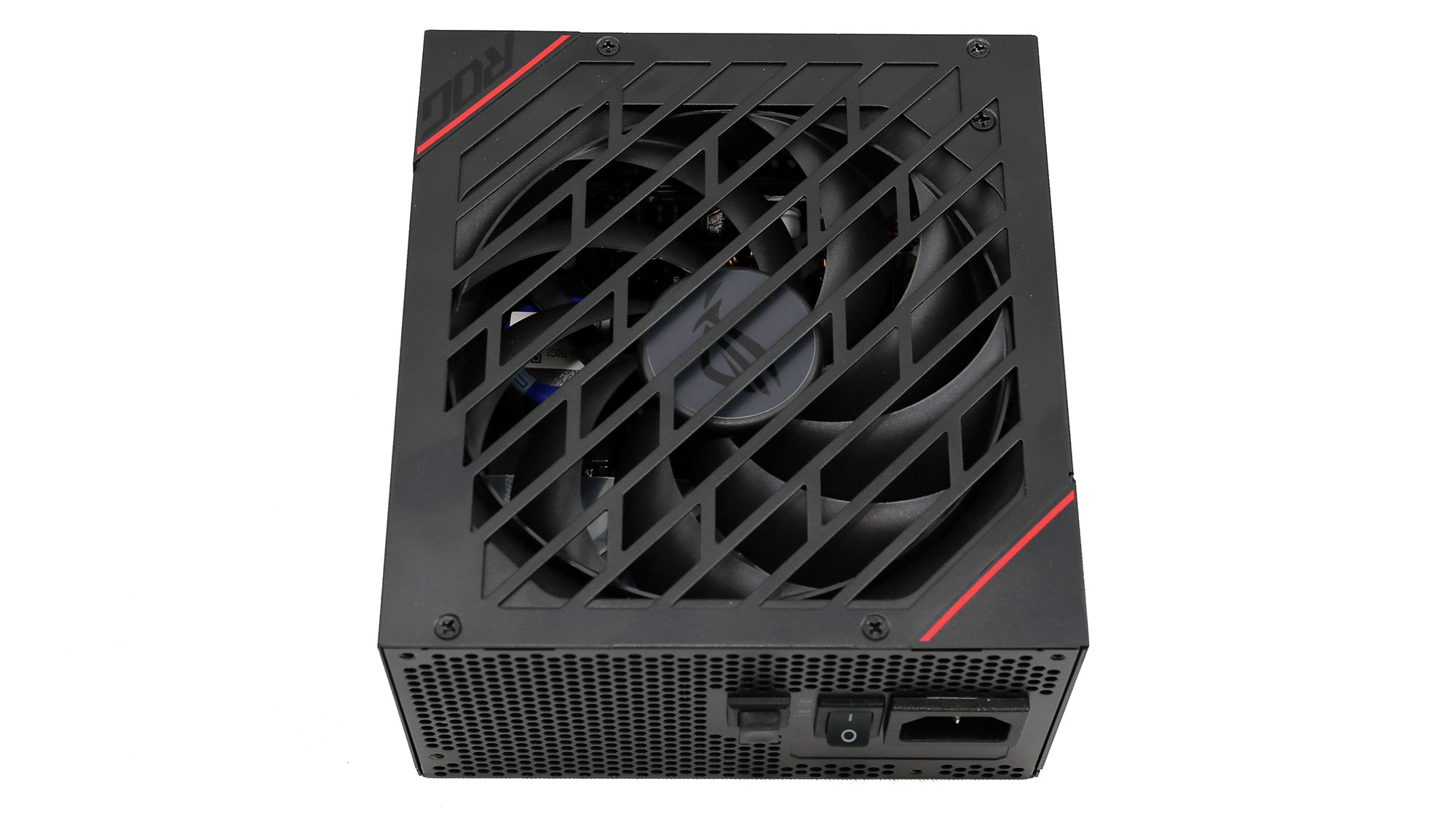






The ROG Strix 750 is fully modular and comes with two EPS and four PCIe connectors, so it will easily support a potent system. Besides an 80 PLUS Gold certification, it also bears efficiency and noise certifications by Cybenetics, ETA-A, and LAMBDA-A, respectively.

Product Photos






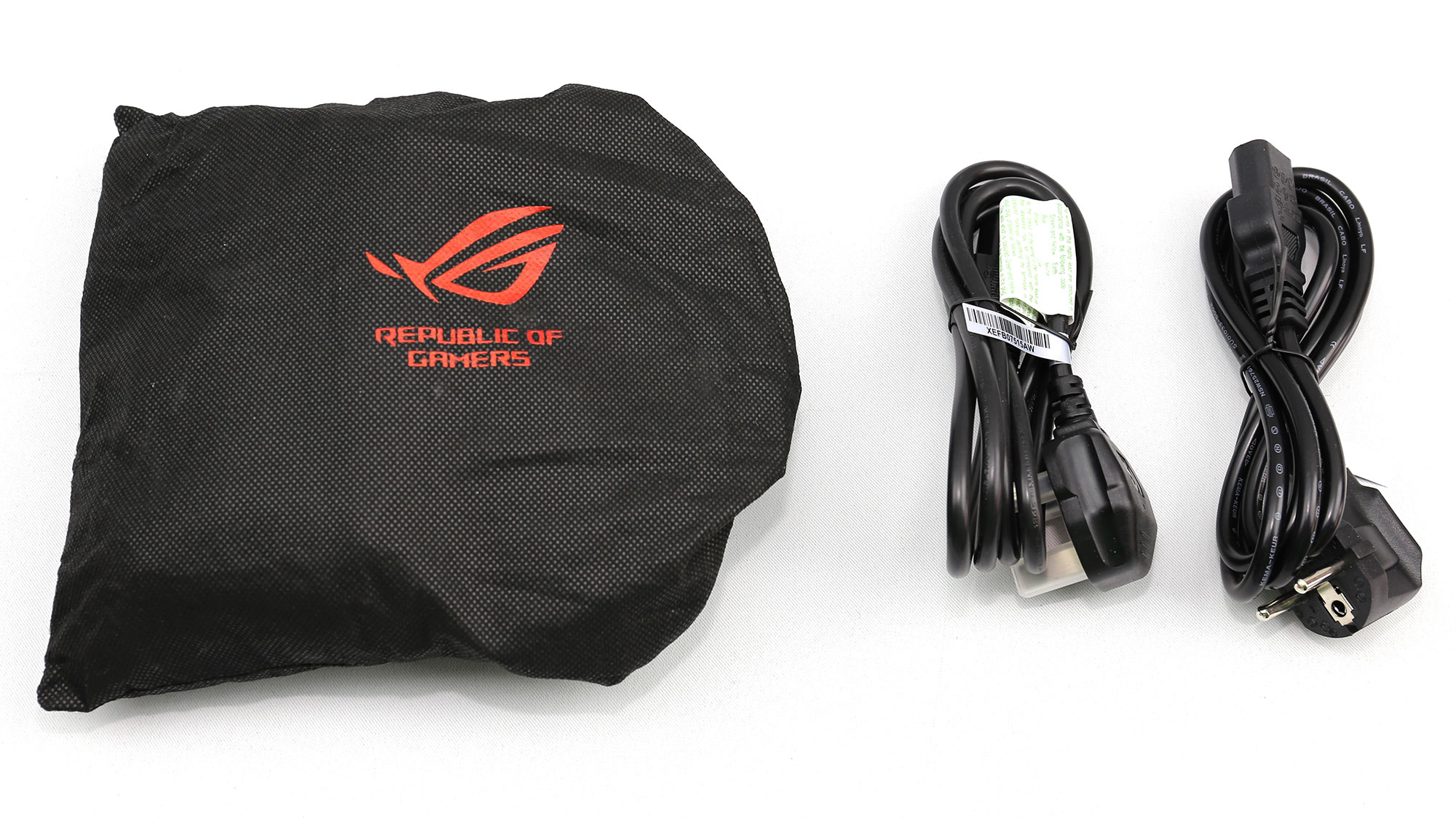
Specifications
|
Manufacturer (OEM) |
Seasonic |
|
Max. DC Output |
750W |
|
Efficiency |
80 PLUS Gold, ETA-A (88-91%) |
|
Noise |
LAMBDA-A (20-25 dB[A]) |
|
Modular |
✓ (Fully) |
|
Intel C6/C7 Power State Support |
✓ |
|
Operating Temperature (Continuous Full Load) |
0 - 50°C |
|
Over Voltage Protection |
✓ |
|
Under Voltage Protection |
✓ |
|
Over Power Protection |
✓ |
|
Over Current (+12V) Protection |
✓ |
|
Over Temperature Protection |
✓ |
|
Short Circuit Protection |
✓ |
|
Surge Protection |
✓ |
|
Inrush Current Protection |
✓ |
|
Fan Failure Protection |
✗ |
|
No Load Operation |
✓ |
|
Cooling |
140mm Double Ball-Bearing Fan (FB14025BH) |
|
Semi-Passive Operation |
✓ (selectable) |
|
Dimensions (W x H x D) |
150 x 85 x 160mm |
|
Weight |
1.83 kg (4.03 lb) |
|
Form Factor |
ATX12V v2.4, EPS 2.92 |
|
Warranty |
10 Years |
Power Specifications
| Rail | 3.3V | 5V | 12V | 5VSB | -12V |
| Max. Power | Amps | 20 | 20 | 62 | 3 |
| Watts | 100 | 744 | 15 | 3.6 | |
| Total Max. Power (W) | 750 |
Cables & Connectors
| Modular Cables | ||||
| Description | Cable Count | Connector Count (Total) | Gauge | In Cable Capacitors |
| ATX connector 20+4 pin (610mm) | 1 | 1 | 18-22AWG | No |
| 4+4 pin EPS12V (1000mm) | 2 | 2 | 18AWG | No |
| 6+2 pin PCIe (680mm+80mm) | 2 | 4 | 18AWG | No |
| SATA (450mm+115mm+115mm+115mm) | 1 | 4 | 18AWG | No |
| SATA (410mm+150mm+150mm+150mm) | 1 | 4 | 18AWG | No |
| 4 pin Molex (450mm+120mm+120mm) | 1 | 3 | 18AWG | No |
| AC Power Cord (1400mm) - C13 coupler (EU) | 1 | 1 | 18AWG | - |
| AC Power Cord (1370mm) - C13 coupler (British) | 1 | 1 | 18AWG | - |
There is a large number of connectors, including two EPS, which is the trend nowadays for most mid-capacity power supplies. The length of the EPS cables is impressive, at one meter. ROG made sure that there won't be a compatibility issue with the EPS cables of this unit, even with large full tower chassis.
The first SATA cable has enough distance between the connectors, while the second SATA cable has a smaller distance for drives installed nearby. Unfortunately, the 4-pin Molex connectors only have 120mm distance between them, while the ideal is 150mm.

Cable Photos



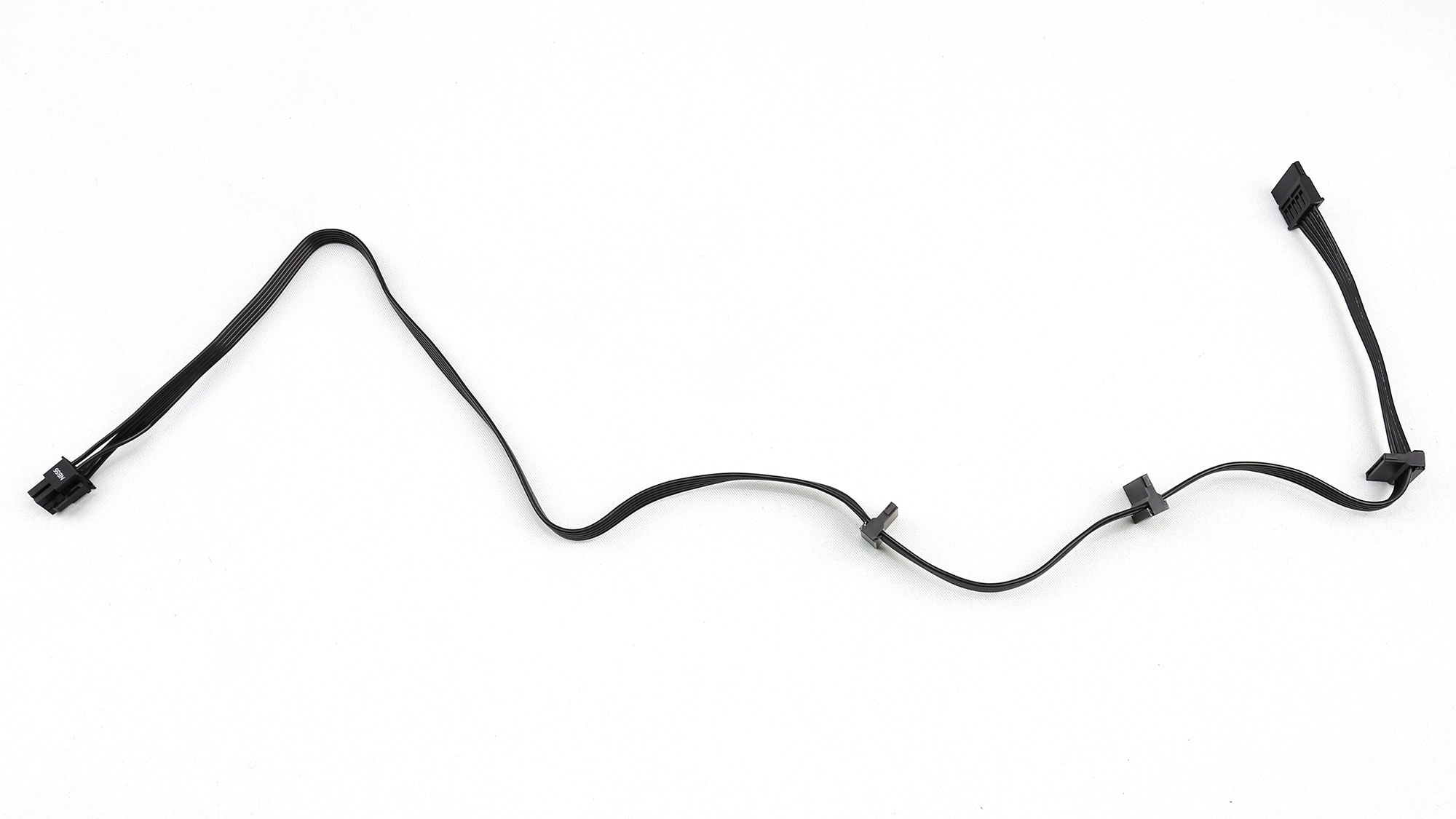



Component Analysis
We strongly encourage you to have a look at our PSUs 101 article, which provides valuable information about PSUs and their operation, allowing you to better understand the components we're about to discuss.
| General Data | |
| Manufacturer (OEM) | Seasonic |
| PCB Type | Double Sided |
| Primary Side | |
| Transient Filter | 4x Y caps, 2x X caps, 2x CM chokes, 1x MOV, 1x Discharge IC |
| Inrush Protection | NTC Thermistor & Relay |
| Bridge Rectifier(s) | 2x GBU1508 (800V, 15A @ 100°C) |
| APFC MOSFETs | 2x Infineon IPP50R140CP (550V, 15A @ 100°C, 0.14Ohm) |
| APFC Boost Diode | 1x STMicroelectronics STTH8S06 (600V, 8A @ 25°C) |
| Hold-up Cap(s) | 1x Hitachi (400V, 560uF, 2,000h @ 105°C, HU) |
| Main Switchers | 4x Champion GPT10N50ADG (500V, 9.7A, 0.7Ohm) |
| APFC Controller | Champion CM6500UNX |
| Resonant Controller | Champion CM6901T6 |
| Topology | Primary side: Full-Bridge & LLC converter Secondary side: Synchronous Rectification & DC-DC converters |
| Secondary Side | |
| +12V MOSFETs | 4x Nexperia PSMN2R6-40YS (40V, 100A @ 100°C, 3.7mOhm @ 100°C) |
| 5V & 3.3V | DC-DC Converters:4x ON Semiconductor NTMFS4C028N (30V, 12.3A @ 80°C, 4.73mOhm) PWM Controllers: ANPEC APW7159C |
| Filtering Capacitors |
Electrolytic: 3x Nippon Chemi-Con (105°C, W), 5x Nippon Chemi-Con (4-10,000h @ 105°C, KY), 5x Nichicon (4-10,000h @ 105°C, HE) |
| Supervisor IC | Weltrend WT7527V (OCP, OVP, UVP, SCP, PG |
| Fan Model | Everflow FB14025BH (135mm, 12V, 0.60A, Ball Bearing Fan) |
| 5VSB Circuit | |
| Rectifier | 1x PFC P10V45SP (45V, 10A) |
| Standby PWM Controller | Excelliance MOS EM8569 |

Overall Photos

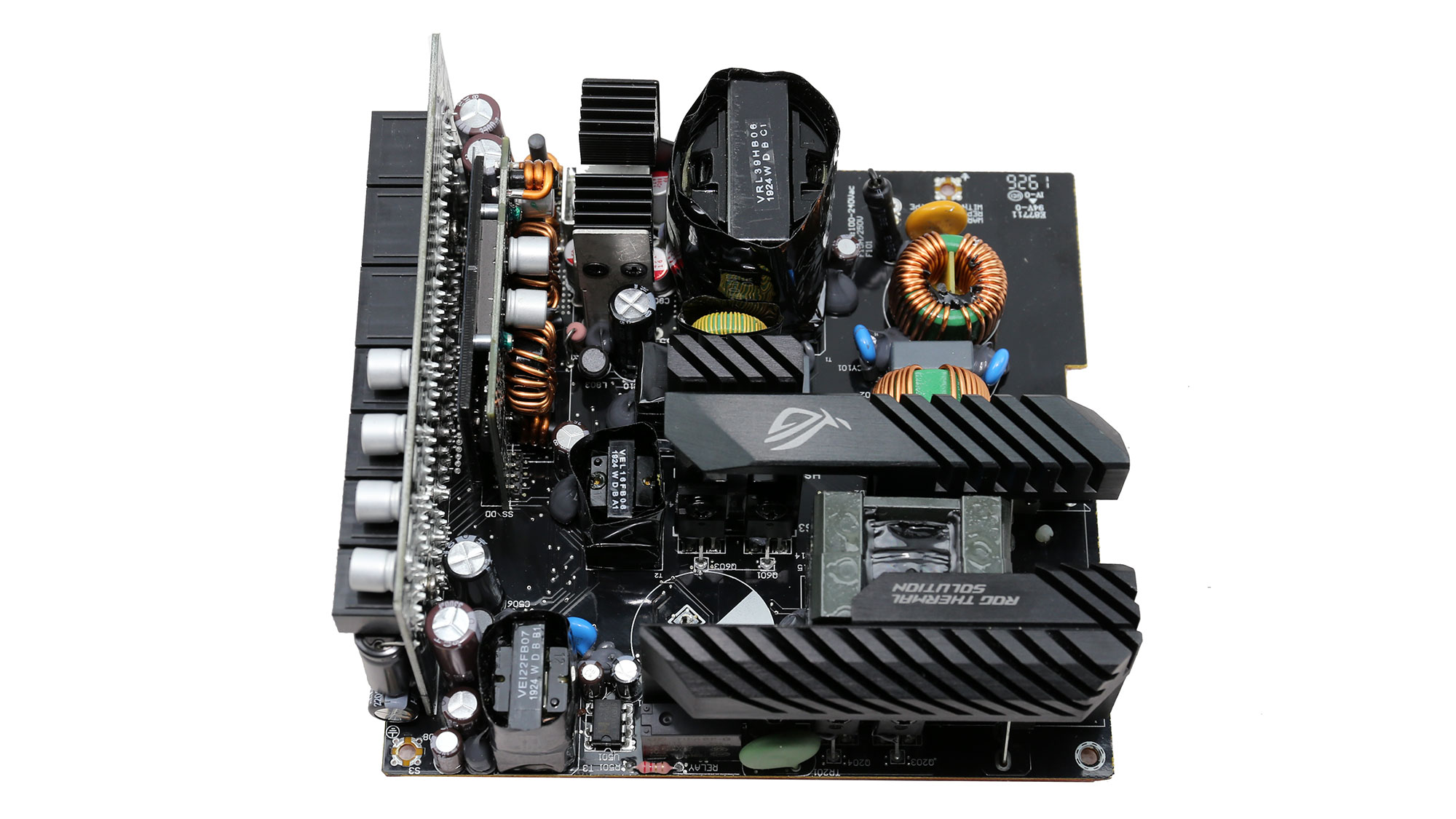
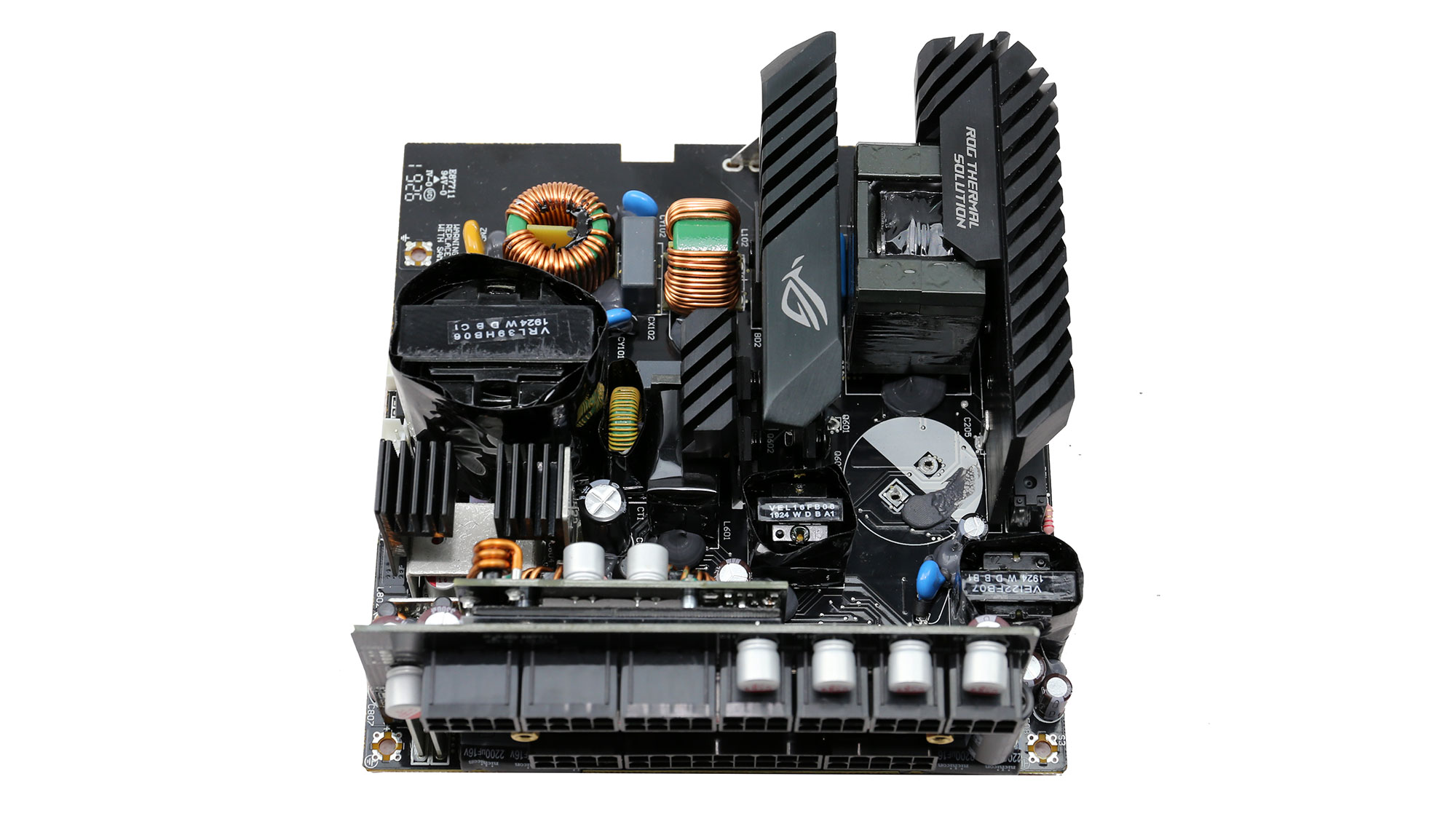
The PCB is a bit larger than the Seasonic GX-750 unit in order to accommodate the large APFC and primary heat sinks, which help in relaxing the fan speed profile. Moreover, the smaller heat sink that hosts the primary FETs has pretty large fins to dissipate heat faster. Besides the larger heat sinks and the different fan, there are no other notable differences with the similar capacity Focus Plus model.
Get Tom's Hardware's best news and in-depth reviews, straight to your inbox.

Transient filter





The transient filter has two stages and has all the necessary parts, including four Y and two X caps, a discharge IC, two CM chokes, and an MOV.

Bridge rectifiers

The pair of bridge rectifiers can handle up to 30 Amps of current.

APFC converter



The APFC converter uses a pretty large bulk cap, which offers a longer than 17ms hold-up time. Right in front of the converter's FET and boost diode, we also find the NTC thermistor and relay combo, responsible for protection against large inrush currents.

Main FETs and primary transformer

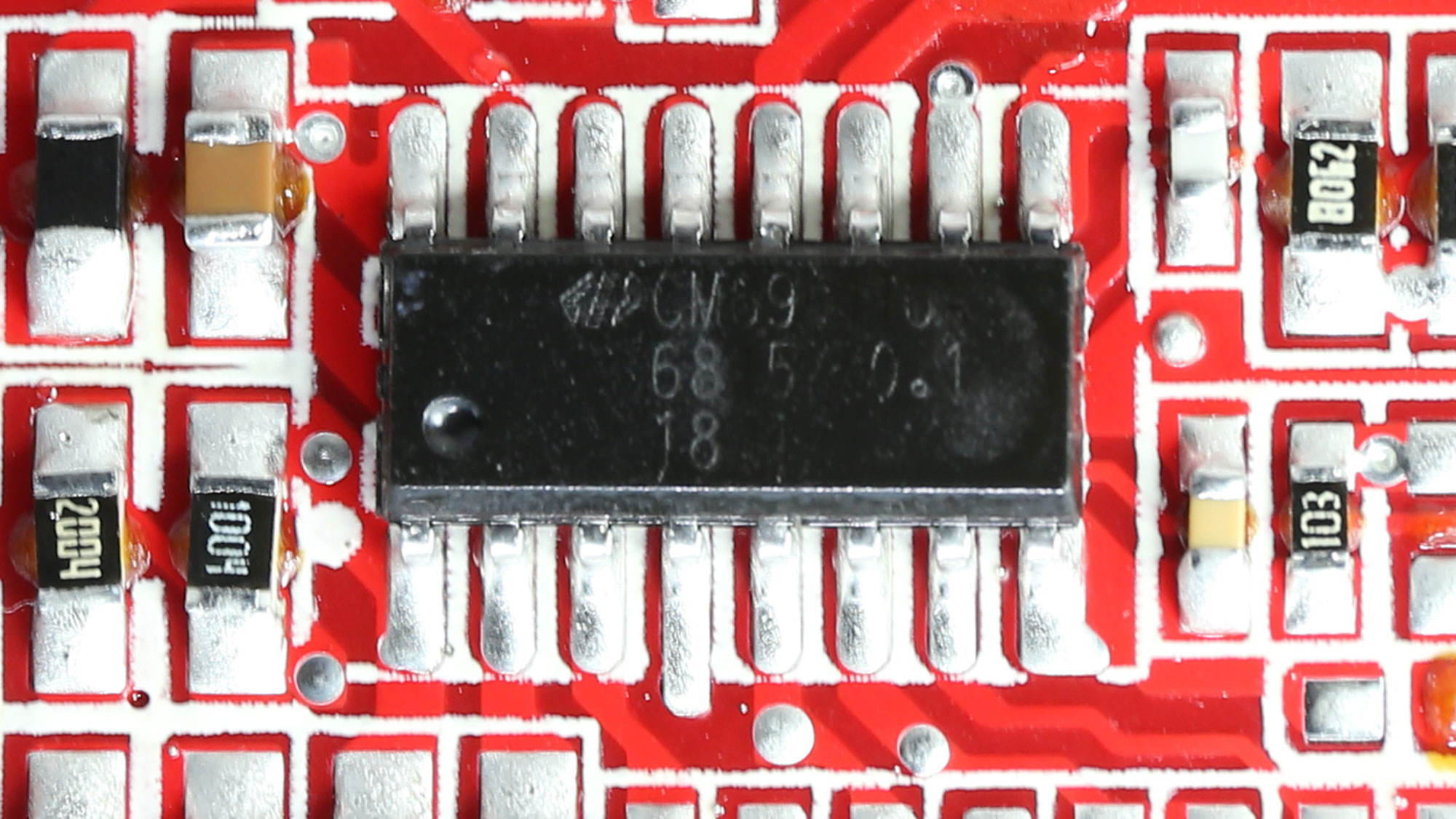


The primary switching FETs are provided by Champion and are arranged in a full-bridge topology. Typically, an LLC resonant converter is used to boost efficiency.

12V FETs and VRMs


The +12V FETs are installed on the solder side of the PCB. The pair of heat sinks above them is used to cool them down. Two DC-DC converters are also used to generate the minor rails.

Filtering caps


The electrolytic filtering caps mostly belong to good Chemi-Con and Nichicon lines, with an increased lifetime. A large number of polymer caps are also used.

5VSB Circuit

The standby PWM controller is an Excelliance MOS EM8569 IC.

Modular board front


Lots of polymer caps are installed at the face of the modular PCB.

Soldering quality







The soldering quality is very good, and on this side of the PCB, we also find several key components, including the APFC and resonant controllers, along with several diodes, the +12V FETs, and the supervisor IC.
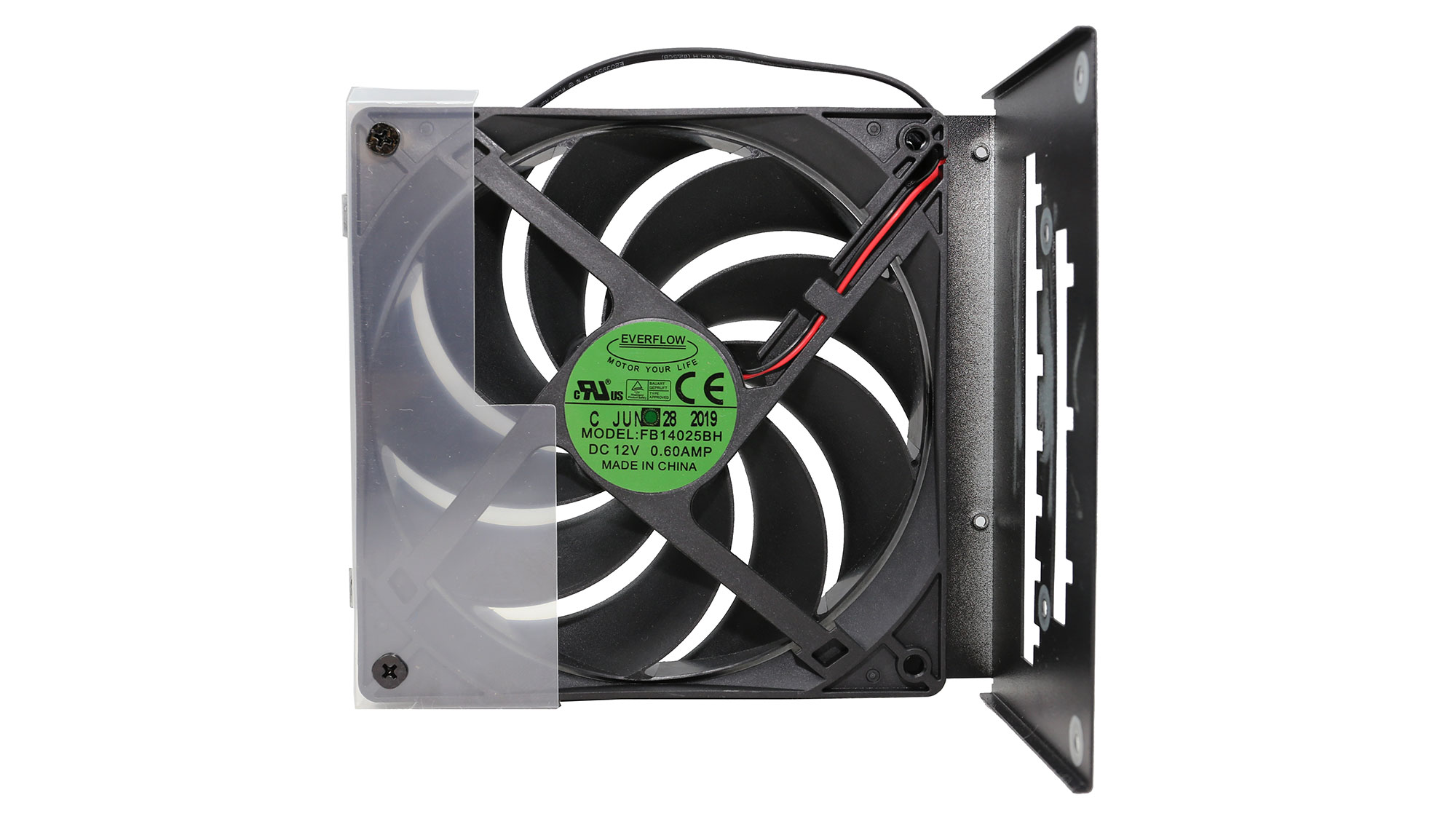
Cooling fan

Contrary to its competitors, the ROG unit uses a double ball-bearing fan. This fan produces more noise, under the same operating conditions, compared to the sleeve, riffle, and fluid dynamic bearing ones, but they can handle increased temperatures without sweating. This is not a case for FDB fans whose life significantly degrades once the operating temperatures exceed 40 degrees Celsius.
MORE: Best Power Supplies
MORE: How We Test Power Supplies
MORE: All Power Supply Content
Current page: Specifications and Part Analysis
Next Page Load Regulation, Hold-Up Time, Inrush Current, Efficiency and Noise
Aris Mpitziopoulos is a contributing editor at Tom's Hardware, covering PSUs.
-
octavecode I was about to say "looks a lot like a Seasonic unit" then i checked the manufacturer. :PReply
Best PSU reviewer , greetings from Greece.
Stay strong and healthy everybody. -
Aris_Mp Replyoctavecode said:I was about to say "looks a lot like a Seasonic unit" then i checked the manufacturer. :p
Best PSU reviewer , greetings from Greece.
Stay strong and healthy everybody.
Thank you for your kind words! -
karthyks Not sure if I got a faulty unit. I built a PC with Ryzen 3900x and Gigabyte Rtx 2080 Super along with this PSU. And it failed me after 3 days. My PC shuts down whenever I login to windows and randomly when I open a exe file. After swapping new motherboard, new Ram, new graphics card, i found the problem is with PSU. And I use thermaltake 850W 80+ and now everything is good so far.Reply -
SlavkoBilder Reply
its not because of the psu, the psu is good, but it doesnt have enough volts to power that cpu and graphics, its like a mouse is pushing a steel cube, just doesnt work out.karthyks said:Not sure if I got a faulty unit. I built a PC with Ryzen 3900x and Gigabyte Rtx 2080 Super along with this PSU. And it failed me after 3 days. My PC shuts down whenever I login to windows and randomly when I open a exe file. After swapping new motherboard, new Ram, new graphics card, i found the problem is with PSU. And I use thermaltake 850W 80+ and now everything is good so far. -
Schlachtwolf ReplySlavkoBilder said:its not because of the psu, the psu is good, but it doesnt have enough volts to power that cpu and graphics, its like a mouse is pushing a steel cube, just doesnt work out.
A 750w PSU is more than enough for a 3900x which itself will never really get over 150w, and an RTX 2080 super, but back to the theme I have the ROG Thor 850w and it is the best PSU I ever had in my 25 years having a PC. Asus is not cheap in any facet of hardware but the quality of their components is some of the best out there. -
PizzaChet Hi all! I just bought a bunch of ROG parts and got the THOR 850W PS. I've been seeing some similar builds out there and some say if you OC the CPU, it might get a little tight on wattage. Could you please share what you all think is a safe amount of overhead? I haven't decided on how far I want to go on overclocking yet. Here's the current list and estimated wattage...Reply
PC Parts Picker estimated the wattage of this build at 538W
MSI GeForce RTX 3070 Ventus 2X OC Gaming Graphics Card, 8GB GDDR6, PCIe 4.0, Ray Tracing, VR Ready, 3X DisplayPort 1.4, 1x HDMI 2.1 8K, DirectX 12 Ultimate, TORX Fan 3.0 w/ Mytrix HDMI CableIntel Core i9-10900X Desktop Processor 10 Cores up to 4.7GHz Unlocked LGA2066 X299 Series 165W (BX8069510900X)
SAMSUNG 970 EVO Plus SSD 2TB - M.2 NVMe Interface Internal Solid State Drive with V-NAND Technology (MZ-V7S2T0B/AM)
ASUS ROG Thor 850 Certified 850W Fully-Modular RGB Power Supply with LiveDash OLED Panel
Asus ROG Strix Helios GX601 RGB Mid-Tower Computer Case for up to EATX Motherboards with USB 3.1 Front Panel, Smoked Tempered Glass, Brushed Aluminum and Steel Construction, and Four Case Fans, Black
ASUS ROG Strix LC 360 RGB All-in-one AIO Liquid CPU Cooler 360mm Radiator, Intel 115x/2066 and AMD AM4/TR4 Support, Triple 120mm 4-pin PWM Fans (Addressable RGB Fans)
2x Corsair Vengeance RGB Pro 32GB (2x16GB) DDR4 3200 (PC4-25600) C16 Desktop Memory - Black (CMW32GX4M2C3200C16)
ASUS ROG Strix X299-E Gaming II ATX Gaming Motherboard (Intel X299) LGA 2066, Wi-Fi 6 (802.11ax), 2.5 GBS LAN, 8X DIMM Max. 256GB, USB 3.2 Gen 2, 8X SATA, 3X M.2, OLED and Aura Sync RGB -
Schlachtwolf I have that PSU too, you will be fine with 850w. Normally you allow for 20% overhead, you still have plenty of room.....Reply